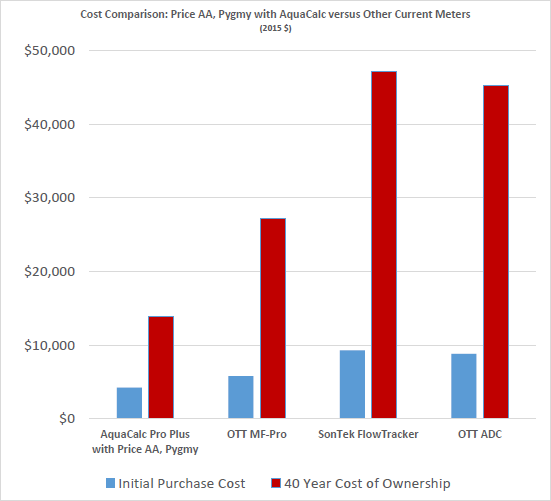 Loading... Please wait...
Loading... Please wait...Hydrological Equipment
NEWS RELEASE
Cost and Accuracy Comparisons

Mechanical Current Meter System with AquaCalc Versus Other Point Velocity Discharge Systems
Download PDF
Sediment Sampling
 Sediment measurement involves sampling the water-sediment mixture to determine the mean suspended sediment concentration, particle size distribution, specific gravity, temperature of the water sediment mixture, and other physical and chemical properties of the transported solids. Suspended sediment concentration in a natural stream varies from the water surface to the streambed and laterally across the stream. Concentration generally increases from a minimum at the water surface to a maximum at or near the streambed. The samplers available here have been designed by the U.S. Federal Interagency Sedimentation Project (FISP).
Sediment measurement involves sampling the water-sediment mixture to determine the mean suspended sediment concentration, particle size distribution, specific gravity, temperature of the water sediment mixture, and other physical and chemical properties of the transported solids. Suspended sediment concentration in a natural stream varies from the water surface to the streambed and laterally across the stream. Concentration generally increases from a minimum at the water surface to a maximum at or near the streambed. The samplers available here have been designed by the U.S. Federal Interagency Sedimentation Project (FISP).
Depth Integrating Samplers
Depth integrating samplers are designed to continuously extract a sample as they are lowered from the water surface to the streambed and returned at a constant rate of travel. Ascending and descending speeds need not be the same, but the rate of travel must be constant in each direction. As the sample is collected, air in the container is compressed so that the pressure balances the hydrostatic pressure at the air exhaust and the inflow velocity is approximately equal to the stream velocity.
Point Integrating Samplers
Point integrating samplers are equipped with an electrically controlled rotary valve which opens and closes the sampler on command. They are designed to take a sample at any point in a stream over a short time interval. With the control valve fixed in the open position, these samplers are also used to obtain depth integrated samples. One-way depth integrated samples may be obtained by opening the valve with the sampler at the water surface and lowering it to the streambed at a constant speed. This permits sampling to greater depths.
Suspended-sediment samplers should be used only with the specified nozzle to give a truly representative sample. All US-series samplers are designed to sample isokinetically which means that water is entering the nozzle at the same speed as the water would be traveling if the sampler wasn't there.
Bedload Samplers
Suspended sediment samplers will only sample to a point about 0.3 foot (9.1 cm) above the streambed. The sediment transported in the unsampled zone is composed of both suspended load and bedload. The bedload portion is composed of particles having a density or grain size which precludes movement far above or for long distances out of contact with the streambed.
In wide sand-bed streams with shallow flow depths and high sand concentrations, more sediment may be transported in the unsampled zone than in the sampled zone. As flow depth increases, the proportion of sediment in the unsampled zone becomes smaller, often accounting for only a small fraction of the total sediment load.
The bedload portion of sediment discharge is primarily sampled using two styles of bedload samplers, the FISP designed series uses a 1.4 expansion ratio while the widely used Helley Smith series has a 3.22 expansion ratio design.
Bed Material Samplers
Bed material samplers are designed to collect samples from the bed of a stream, or from lake or reservoir deposits. These samplers take an undisturbed consolidated bed sample and are designed to prevent sample washout or disturbance during retrieval. This is an important aspect of bed material sample integrity.
